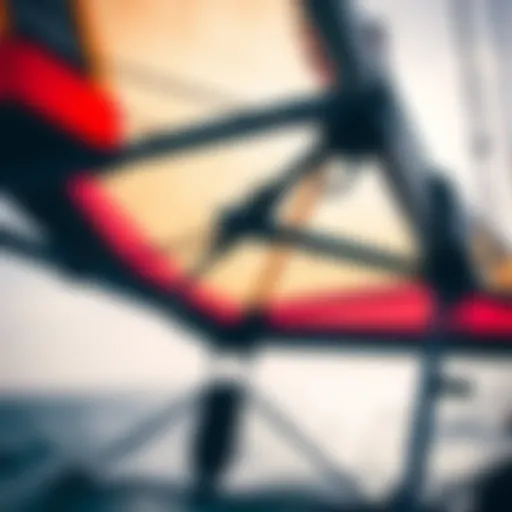Kitesurfing in Cape Town: A Complete Guide


Intro
Kitesurfing, that exhilarating mix of wind and waves, finds a prime home in Cape Town, a city that embraces everything from its majestic Table Mountain to its stunning beaches. For adventurers and thrill-seekers alike, Cape Town's coastline presents an unparalleled stage for this captivating sport.
The rich history of kitesurfing here is woven into the very fabric of the seaside community. The local vibe pulses with energy, particularly in the summer months when the winds blow strong but fair. Riders of all levels flock to the shores, eager to tackle the exhilarating swells and unpredictable gusts that characterize the area. But before diving headfirst into the surf, it's essential to arm yourself with knowledge about the equipment, techniques, and safety measures that can make or break your experience.
In this guide, we will peel back the layers of kitesurfing in Cape Town. We'll touch on the must-have gear, explore the vital safety practices every kiteboarder should adhere to, and share tried-and-true techniques to help you ride like a pro.
Whether you’re a novice taking your first steps onto the board or a seasoned kite maestro seeking an adrenaline rush, this overview shines a bright light on all that Cape Town has to offer. So, let's get ready to harness those winds!
Gear and Equipment
Essential Kiteboarding Gear for Beginners
First things first: what gear do you need to get started on this fantastic water sport? Investors in kitesurfing gear should focus on quality and reliability, even when on a budget. A kite, harness, and board are your foundational items.
- Kite: Starting off, a good inflatable kite is a must. Look for something in the 5 to 9 meters range—ideally, the size should suit the wind conditions you expect to encounter. One well-regarded brand to check out is North Kites, known for its durable and easy-to-handle options.
- Harness: The harness connects you to the kite and supports your lower back. Opt for a waist harness as a beginner, as it allows for more freedom of movement.
- Board: Beginners should choose a larger board, which provides more stability and easier navigation. The direction of the board is crucial; a twin tip type is preferable as it allows for riding in both directions.
- Safety Gear: Don’t skip the impact vest and helmet—safety is the name of the game.
Investing in good-quality gear from the beginning can save you from unnecessary hassle and enhance your overall experience.
Advanced Equipment for Experienced Riders
Once you’ve emerged from the beginner's cocoon, it’s time to explore the universe of advanced gear. Experienced riders often seek specialized equipment to fine-tune their performance.
- Performance Kites: In this realm, look for kites designed for specific conditions or tricks. Brands like Cabrinha offer high-performance options that cater to various styles from freestyle to wave riding.
- Lightweight Boards: As skills grow, so does the need for agility. Using lightweight boards enhances jumping and maneuverability, allowing for more complex tricks.
- Upgrade Harness: Consider a seat harness if you're into freestyle; it often offers better support for high-impact landings.
- Safety Insurance: Always keep a kite knife handy. It’s a small yet important tool that allows you to quickly cut away from tangled lines in emergencies.
While this advanced equipment can be pricey, the improvements in performance and safety just might make all the difference in reaching new heights—both literally and metaphorically.
"Kitesurfing isn't just a sport; it’s a way to connect with nature and express yourself on the water."
Techniques and Tips
Safety Practices for Kiteboarding
Understanding safety is paramount. Even the most experienced kiteboarders can find their day ruined by a careless moment. Here are key practices:
- Know Your Environment: Familiarize yourself with the launch and landing areas. Avoid crowded beaches and always keep a lookout for obstacles.
- Wind Awareness: Pay close attention to wind conditions, shifts, and potential changes throughout the day. Learning how to read the wind can save your skin.
- Buddy System: Whenever possible, kite with a partner. Not only does it enhance safety, but companionship makes for a richer experience.
- Emergency Protocols: Practice using safety releases and getting out of the water quickly. Emergencies can pop up without warning.
Training Techniques to Improve Your Skills
Once safety is in check, it’s time to hone those skills. Start with:
- Consistency: Like anything, practice makes perfect. Regular sessions help in building muscle memory.
- Video Analysis: Filming your rides allows you to spot areas for improvement and discuss techniques with instructors or friends.
- Professional Lessons: Even if you’re not a rookie, taking a refresher course or attending a workshop can offer fresh insights.
By delving deep into both gear and technique, newcomers and seasoned riders alike can enjoy everything that kitesurfing in Cape Town has to offer. With picturesque views and thrilling experiences, the wind's your only limit in this captivating playground.
Preface to Kitesurfing in Cape Town
Kitesurfing, a thrilling blend of wind and water, has become more than just a sport in many coastal cities—it’s a lifestyle. Cape Town stands out in this regard, offering some of the best conditions for kitesurfing enthusiasts around the globe. This section serves as a primer on why this magnificent city is a haven for both beginners and seasoned riders alike.
Overview of Kitesurfing
Kitesurfing marries aspects of surfing, paragliding, and sailing, where participants utilize a large kite to capture the wind's power, propelling themselves across the water on a board. It's an activity that fosters camaraderie and passion for the ocean, creating a unique vibe that’s hard to resist.
The sport can be both exhilarating and accessible; many find joy in the challenge of mastering it. With the right instruction, even those with zero experience can get the hang of it relatively quickly. Kitesurfing not only boosts physical fitness but also fosters mental strength as riders learn to read the weather conditions, work with the elements, and develop skills like balance and coordination.
Furthermore, kitesurfing also encourages a spirit of adventure and exploration as riders seek out new spots and tackle varying conditions. It’s not just about the thrill; it’s the lifestyle, the community, and the connection to nature.
Cape Town: A Kitesurfing Hotspot
Cape Town’s geography presents an ideal playground for kitesurfers. The city is flanked by remarkable mountains, striking beaches, and an extensive coastline, which offer not only stunning views but distinctly varied kitesurfing experiences. Whether you’re riding the waves at Bloubergstrand or catching the winds at Langebaan, it feels like the world is converging here to embrace this exhilarating sport.
Key factors that make Cape Town a prime destination include:
- Reliable Wind: With consistent summer winds often reaching around 20-30 knots, kitesurfers get plenty of opportunities to ride.
- Diverse Spots: From flat water lagoons to ocean waves, there is something for every skill level.
- Vibrant Community: The local kitesurfing culture is alive and buzzing, where enthusiasts gather for events, parties, and informal meet-ups. This camaraderie enhances the experience, making it a key reason why many return to Cape Town year after year.
In essence, kitesurfing in Cape Town is not just about the act itself but is deeply interwoven with the culture and lifestyle of the city. As we delve deeper into this comprehensive guide, prepare to uncover practical advice, safety practices, and insights that will enhance every kitesurfing adventure.


Historical Context of Kitesurfing in Cape Town
Understanding the historical context of kitesurfing in Cape Town is key to appreciating not only the sport itself but also the vibrant culture it fosters. Kitesurfing didn’t just pop up overnight; it has roots and a story that intertwines with the evolution of water sports in the region. This part of the guide is designed to shine a light on how this exhilarating sport came to be a beloved activity amongst locals and visitors alike.
Development of the Sport
Kitesurfing may seem like a modern adventure sport, but its origins can be traced back to the late 1980s. While the activity was pioneered in regions such as Hawaii and France, it wasn't long before Cape Town caught the wind of this up-and-coming trend. Cities along the coast began to embrace the sport, and it blossomed in the 1990s, carving a niche as one of the main attractions for thrill-seekers.
Kitesurfing gained momentum primarily due to a combination of consistent winds and expansive beaches that the Mother City offers. Bloubergstrand, for instance, became one of the premier spots for kitesurfers, with its breathtaking view of Table Mountain adding to the appeal. As more enthusiasts began to flock to the area, the sport not only grew in numbers but also in style and innovation.
The development of the kitesurfing equipment itself played a significant role in the growth of the sport. Early equipment was rudimentary, with safety concerns frequently surfacing. However, manufacturers continuously improved designs, leading to heightened performance and safety measures. As these innovations trickled down to everyday kitesurfers, participation surged, leading to a broader kitesurfing community.
Notable Events and Competitions
Events and competitions have been pivotal in placing Cape Town firmly on the kitesurfing map. National and international competitions, such as the Red Bull King of the Air, have showcased the skills of talented riders while simultaneously drawing attention to the local scene. Each event, apart from promoting the sport, acts as a vibrant celebration of the city’s local talent and global presence.
Communities often organize smaller competitions as well, fostering camaraderie and reducing the barriers for newcomers, encouraging participation instead of intimidation. This blend of elite competitiveness and local engagement has cemented the city as a staple in the kitesurfing calendar.
Kitesurfing schools began sprouting up all over the coast, further catalyzing interest in the community. These institutions took students from zero to hero, making the sport accessible for all. The positive feedback loop between experienced riders and novices enriched Cape Town's kitesurfing culture, adding layers of experience, wisdom, and storytelling to the shorelines.
"Kitesurfing isn’t just a sport; it’s a lifestyle that binds our community together, inspiring us to ride, learn, and grow as one."
In summary, the historical context of kitesurfing in Cape Town serves as a foundation upon which the current kitesurfing community thrives. As the sport evolved over the years, it fostered a culture of innovation, unity, and, importantly, respect for the local environment. This context not only enriches the sport but also offers insight into how a simple board and a kite can become a medium for community connection and personal expression within the breathtaking landscapes of Cape Town.
Wind Conditions and Seasons
Kitesurfing is a sport deeply intertwined with wind patterns and seasons, especially in a location as vibrant as Cape Town. The success and enjoyment of this adrenaline-driven activity hinges on understanding these elemental factors, as they dictate not only the conditions of the ocean but also the overall experience of the kitesurfer. A keen grasp of wind dynamics allows enthusiasts to safely navigate the waters, while maximizing their time on the water by choosing the right moments to hit the waves.
Understanding Cape Town Winds
Cape Town is renowned for its unique wind characteristics, which play a pivotal role in shaping its kitesurfing profile. The predominant wind in this region is the Cape Doctor, a strong southeasterly wind that typically whips through from late October to March. This wind tends to be consistent, reliable, and brisk, often reaching speeds that can challenge even the most seasoned kitesurfers.
It's important to note that winds can vary significantly depending on the location; for instance, areas like Bloubergstrand may experience a different intensity compared to Langebaan. The alignment of the landscape and geographical features directs airflow to create microclimatic conditions, giving each kitesurfing spot its unique character. Here’s a breakdown of key winds you’ll encounter:
- Cape Doctor (Southeaster): Offers ideal kitesurfing conditions, with consistent speeds for thrilling rides.
- Northwester: Comes along in summer, though gusty and unpredictable, it can be a fun challenge when conditions align.
- Southwester: Often seen in spring and autumn, it requires more skill to handle due to its variability.
This variability means that kitesurfers, whether new or experienced, should always check local wind forecasts on platforms like WindGuru or Windy before heading out.
Best Seasons for Kitesurfing
Timing is everything in kitesurfing, and for those looking to ride the waves in Cape Town, the seasons play a crucial role. The prime kitesurfing months often stretch from late October through March. Here's a quick overview of what to expect during these months:
- Early Summer (November to December): As summer kicks in, the winds begin to strengthen. It's a popular time, with more kitesurfers flocking to spots like Bloubergstrand. Expect consistent winds that are great for both learners and veterans alike.
- Peak Summer (January to February): This is the golden period for kitesurfers. The winds are at their strongest, and the beaches come alive with activity. Ideal for those ready to push their limits and hone their skills!
- Late Summer to Early Autumn (March): Winds might start to mellow, but you can still enjoy reliable conditions, plus a few fewer crowds!
In contrast, the winter months (June to August) can be less predictable, with wind conditions becoming significantly variable. As temperatures drop, strong cold fronts may occasionally bring storms, which are less favorable for kitesurfing. Wave conditions can also be quite challenging, with larger swells and gustier winds that might not suit beginners.
Overall, the winds of Cape Town offer both challenges and thrills, shaping the experience of every kitesurfer on its pristine waters. For those willing to adapt and learn the nuances of wind patterns, each session can become a unique adventure.
Top Kitesurfing Spots
Kitesurfing in Cape Town is not just about wind and waves; it's also about choosing the right location. The area boasts some of the best kitesurfing spots globally, each with its own unique character and vibe. Selecting the right beach can greatly enhance the kitesurfing experience—offering everything from stunning scenery to reliable wind conditions. In this section, we explore three of the top kitesurfing locations: Bloubergstrand, Langebaan, and Muizenberg. Each spot has its distinct features, which can cater to different skill levels and preferences.
Bloubergstrand
Bloubergstrand is, without a doubt, the crown jewel of Cape Town's kitesurfing scene. This location is famous for its breathtaking views of Table Mountain and Robben Island, creating a picturesque backdrop as you ride the waves. The area consistently receives the notorious southwest winds, known to blow at a steady pace, making it ideal for both beginners and seasoned kitesurfers.
One of the defining advantages of Bloubergstrand is the wide, sandy beach, which allows plenty of space for launching kites and practicing tricks. With its vibrant kitesurfing community, you can easily find fellow enthusiasts to share tips or even join you for a session. As the sun sets over the Atlantic, the atmosphere shifts from adrenaline to relaxation, where riders gather at nearby cafes to swap stories and enjoy the sunset.
"A day at Bloubergstrand isn't just about kitesurfing; it's about immersing oneself in a lifestyle that thrives on adventure and camaraderie."
Langebaan
A bit outside of the city, Langebaan provides a different flavor of kitesurfing. Located within a lagoon, Langebaan boasts flat water and steady winds, making it a hotspot for beginners who are looking to find their sea legs. The shallow waters are inviting, and the scenic beauty of surrounding landscapes enhances the experience.
The calm conditions in Langebaan mean that you can spend hours on the water practicing new techniques without the worry of hefty waves knocking you down. In addition, the windy days can often lead to cooler evenings, perfect for cozy get-togethers with fellow riders. This tends to foster a tight-knit community where newcomers feel welcomed and supported.
Muizenberg
Moving south, we find Muizenberg, known more for its vibrant beach culture and less intense conditions compared to the previous spots. This beach is often a starting point for many fresh kitesurfers, featuring a laid-back atmosphere complemented by colorful beach huts that add charm to the scenery. The winds here are also reliable, favoring a steady north-northwest, which can be ideal for learning the ropes.
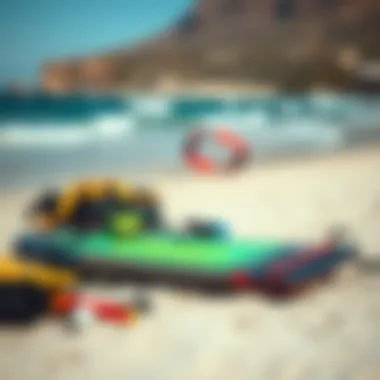
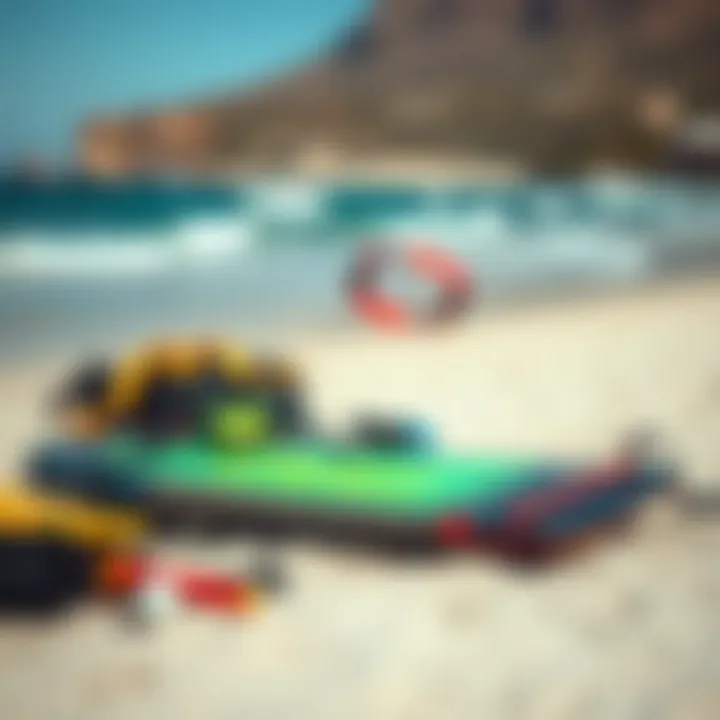
The popularity of Muizenberg draws not just kitesurfers but also surfers and paddleboarders, creating a diverse mix of water sports enthusiasts. This local vibe makes it an excellent choice for those who like to socialize after their sessions. Beachfront cafes provide a perfect spot to relax while enjoying a post-kitesurf snack.
In summary, Cape Town’s top kitesurfing spots each offer unique attributes that cater to various preferences and skill levels. Whether it’s the stunning views and extensive space at Bloubergstrand, the tranquil flat waters of Langebaan, or the community spirit of Muizenberg, each beach contributes to the rich tapestry of Cape Town’s kitesurfing landscape. By exploring these locations, enthusiasts can find the perfect match for their kitesurfing adventure.
Kitesurfing Equipment and Gear
Understanding the essential gear for kitesurfing is pivotal for both new and seasoned riders. The right equipment not only enhances the overall experience, -- but also ensures safety on the unpredictable waters of Cape Town. Investing in quality gear can make all the difference, from your comfort to your performance, helping you enjoy those stunning waves and winds that this city offers.
Choosing the Right Kite
Selecting a kite is akin to choosing a trusted companion. In Cape Town, where wind patterns can shift like a chameleon, it’s important to align your kite choice with these conditions. Kites come in different shapes and sizes—each designed to handle specific wind conditions. For instance:
- C-Kites: These are well-known for their performance and are preferred by advanced riders for tricks and speed.
- Bow Kites: Ideal for beginner to intermediate kitesurfers, bow kites provide good stability and are easier to control.
As you choose, think about your skill level and the types of conditions you'll encounter. A light-wind kite can be a game changer on those calmer days, while a smaller kite handles strong winds better. Another essential factor is the kite's material and build quality. Durability is key, especially when you’re cruising near rugged shores.
Boards and Accessories
Next up is the board, which is as important as the kite itself. The board you select should complement your riding style and skill level. Here are a few important types of boards:
- Twin Tip Boards: Most common and versatile; great for both beginners and advanced riders. These boards allow for easier transitions.
- Directional Boards: Best fit for those interested in surf-style riding. They are generally better for wave riding but can be trickier for beginners.
In terms of accessories, don’t forget about the harness. A good harness should fit snugly and provide comfort throughout your session. Additionally, consider your foot straps, which should allow for plenty of room for adjustment without sacrificing support.
Safety Gear Essentials
Kitesurfing, while thrilling, has its fair share of risks. Therefore, having the right safety gear isn’t just a recommendation – it’s a necessity. Start with a helmet; it protects your noggin from unexpected falls or collisions. Then, invest in a impact vest for added protection against the water’s surface during high-speed crashes.
And let’s not forget the leash—this simple piece of gear can save you quite a bit of headache. It keeps your kite attached to you, preventing it from flying off uncontrollably.
In addition to these basics, familiarize yourself with the local emergency protocols. Know where to find medical assistance and emergency numbers. A good kitesurfer is not just skilled; they’re also prepared.
"Safety first! Gear up properly before hitting the waves and have a blast without a hitch."
Ultimately, investing in quality kitesurfing equipment and gear will pay dividends not just for your performance, but for your safety and enjoyment on the beautiful waters of Cape Town.
Safety Practices for Kitesurfers
Safety is paramount when it comes to kitesurfing, especially in the dynamic environment of Cape Town. This thrilling water sport presents both opportunities for exhilarating experiences and risks that must be managed responsibly. Understanding and practicing safety protocols not only ensures your well-being but also helps cultivate a respectful kitesurfing culture within the community. By being aware of common risks and preparing for emergencies, kitesurfers can minimize hazards and enjoy their time on the water with peace of mind.
Common Risks and Precautions
Kitesurfing, while entertaining, can expose riders to a variety of risks like any adventure sport. Tackling these risks head-on is essential. Here are some common dangers and how to manage them:
- Wind Variability: Sudden changes in wind can lead to turbulence. Always check the local weather conditions and be prepared to abort a session if the winds become unpredictable.
- Crowded Beaches: With so many enthusiastic riders on popular beaches like Bloubergstrand, collisions can happen. Keeping a safe distance from other kitesurfers is crucial. Don't just follow the crowd; be aware of your surroundings.
- Equipment Failure: This can happen at any moment. Regularly inspect your gear for wear and tear, particularly the lines and the kite itself. A small issue could lead to a significant mishap on the water.
- Swimming Ability: While many kitesurfers are skilled swimmers, it's a common misjudgment to assume that everyone is confident in the water. It’s wise to always wear a flotation vest to enhance safety regardless of skill level.
- Marine Life: Surfing near reefs can expose you to sharp corals and potentially harmful marine creatures. Familiarize yourself with the local fauna and the area's specific warnings.
Implementing precautions like the above can significantly reduce risks and pave the way for safer kitesurfing experiences.
Emergency Protocols
Preparation is a key aspect of safety in kitesurfing. Knowing what to do in an emergency can make all the difference.
- Know your exit points: Before heading out, familiarize yourself with the nearest safe haven to kiteboard back to in case of mishaps. This way, you won't be left stranded.
- Buddy System: Whenever possible, kitesurf with a partner. Inform them of your intended route and maintain visibility on the water. In case of an emergency, having someone close by can be lifesaving.
- Emergency Signals: Establish basic signals with your kitesurfing buddies, like hand gestures for trouble or a need for assistance. Clear signals can expedite help in stressful situations.
- First Aid Knowledge: Being equipped with first aid knowledge is invaluable. Understand how to attend to injuries common in the sport, such as cuts from equipment or falls.
- Rescue Protocols: If you capsize or lose control, prioritize self-rescue techniques. Practice returning to your board and kitesurfing safely back to shore with your kite flags out.
- Communication: Carry a mobile device in a waterproof bag in case of emergencies to reach local authorities if necessary. Having a plan to call for help when needed can be critical.
"Safety isn't just a priority; it’s a way of life in the kitesurfing community. Every rider is responsible for their own safety and that of others."
By adopting these safety practices and being vigilant, kitesurfers can navigate the waves of Cape Town with confidence. The sea can be unpredictable, but a cautious approach allows for a thrilling yet safe ride.
Learning to Kitesurf
Learning to kitesurf holds immense significance for those eager to engage with the exhilarating world of this sport. Not only is it about mastering a physical skill, but it's also about immersing oneself in a community and understanding the local winds and waters of Cape Town. Having a solid foundation in kitesurfing means you'll not only enjoy the thrill of riding the waves but also ensure your safety and the safety of others on the water.
Finding a Kite School
Choosing the right kite school can make or break your kitesurfing experience. Cape Town boasts numerous reputable kite schools, each offering unique training programs tailored to different skill levels. Consider this when scouting for a school:
- Reputation: Research the school's reviews on places like kitesurfing forums or local Facebook groups. Engaging with former students can provide insights into their experiences.
- Instructor Experience: Ensure that the instructors are certified and have several years of teaching under their belts. This not only assures quality but also enhances your learning curve.
- Equipment Quality: Opt for schools that use well-maintained, modern gear, as this can affect your learning process. Obsolete equipment may slow down your progress.
- Location: Different beaches offer varied conditions. A school positioned in a spot like Bloubergstrand, known for its consistent winds, can enhance the learning experience.
- Class Size: Smaller class sizes often mean more personalized attention. If you notice a packed class, you may not get the guidance you need.
Connecting with a kite school not only helps with skill acquisition but also serves as a gateway into the local kitesurfing community.
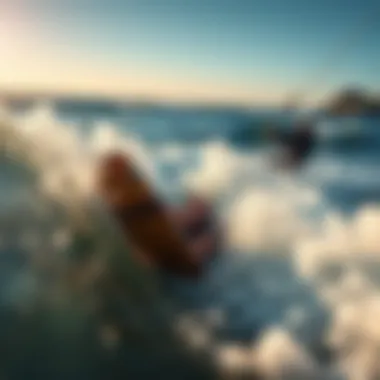
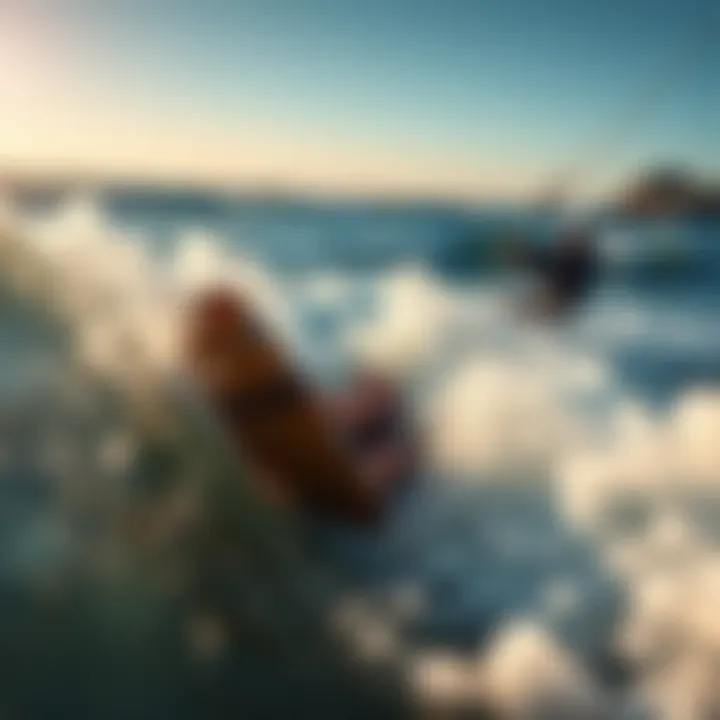
Training Programs and Certifications
Training programs generally vary from one school to another, yet there exists a common thread among them—the goal of providing a structured and safe learning path. When considering a training program, look for:
- Beginner Courses: These typically cover the essentials of kitesurfing, including kite setup, safety protocols, and basic flying techniques. Expect hands-on training along with classroom instruction.
- Intermediate and Advanced Courses: Once you're comfortable, you may want to explore advanced maneuvers like jumping or navigating challenging wind conditions. Some schools even offer specific workshops based on your interests.
- Certifications: Many reputable kite schools follow standardized certification programs such as those set by the International Kiteboarding Organization (IKO) or the American Kitesurfing Association (AKA). Obtaining a certification not only validates your skills but also boosts your confidence. It may also be beneficial if you wish to kiteboard internationally, as certain locations recognize these certifications.
Local Kitesurfing Community and Culture
The local kitesurfing community in Cape Town plays a pivotal role in shaping the experience for both novice and seasoned riders. This culture is not merely about riding the waves; it is about forging connections, sharing knowledge, and creating a vibrant social fabric. Cape Town's beaches become a melting pot of diverse individuals linked by their passion for kitesurfing. Through this collective enthusiasm, the sport flourishes, and the community grows stronger, fostering an environment conducive to learning and exploration. The connections made among kitesurfers emphasize the essence of camaraderie, where mutual support is the norm rather than the exception.
Community Events and Gatherings
Local events serve as the heartbeat of the kitesurfing culture in Cape Town. Regular gatherings, competitions, and social meet-ups happen across various beaches like Bloubergstrand or Langebaan, providing opportunities for riders to exchange tips and techniques.
- Kitesurfing Competitions: There are annual competitions where local riders demonstrate their skills in a spectator-friendly atmosphere. For instance, events like the Cape Town Kitesurfing Championship draw crowds, showcasing top talents and inspiring newcomers.
- Workshops and Clinics: Schools often organize workshops that cover everything from the fundamentals to advanced maneuvers. These sessions not only improve skills but also build lasting friendships amongst participants.
- Social WuTu Retreats: Some local schools and organizations arrange retreats focused on kitesurfing and relaxation. Such initiatives create a laid-back setting for riders to mingle, share experiences, and enjoy the thrill of the ocean.
Building a sense of community also involves being socially responsible. Events often include clean-up efforts at the beaches, fostering an ethic of care not just for the sport but for the environment that supports it. This is crucial for preserving the natural beauty that attracts so many, ensuring future generations can enjoy the same breathtaking vistas and exhilarating rides.
Kitesurfing Influencers and Riders
The influence of local kitesurfing riders and instructors is significant within the community. Many kitesurfing enthusiasts look up to established riders, not only for their skills but also for their ability to inspire and motivate others.
Prominent figures in the Cape Town kitesurfing scene often share valuable insights through social media, illustrating their journeys and the evolution of their craft. This openness encourages newcomers to take a leap into the sport and fosters a sense of belonging. Here are some noticeable perks of the influencers within the local scene:
- Knowledge Sharing: Many riders conduct online tutorials or live sessions, making advanced techniques accessible to those keen to learn.
- Brand Collaborations: Influencers frequently collaborate with brands, showcasing the latest equipment through authentic experiences, guiding novice riders on quality gear.
- Local Legends: The stories and experiences of seasoned riders enrich the fabric of the community, blending tradition with modern innovation in a thorough discussion of the sport's growth.
In summary, the kitesurfing community in Cape Town thrives on interaction, learning, and support. By participating in events and following local influencers, new and experienced kitesurfers alike can ensure a deeper connection to the sport and the environment, creating a legacy of adventure that extends beyond individual rides.
Environmental Considerations
Kitesurfing is not just a thrilling sport; it also intertwines closely with the natural environment. Understanding the interaction between the sport and marine life is crucial for preserving the vibrant ecosystems surrounding Cape Town. As more enthusiasts flock to the waters, awareness of environmental impact becomes increasingly vital. Not only does this keep the beaches and waters beautiful, but it also ensures that kitesurfing remains a sustainable hobby for generations to come.
Impact of Kitesurfing on Marine Life
The diverse marine environment around Cape Town hosts a rich variety of species, from colorful fish to majestic sea turtles. Kitesurfing, while exhilarating, can potentially disrupt this delicate ecosystem if proper care is not taken. For instance, the noise and activity can startle marine wildlife, pushing them away from their natural habitats. Moreover, the physical presence of kitesurfers can lead to damage of fragile coastal areas, such as rocky shorelines and wetlands.
Some research indicates that kitesurfing can affect fish populations, particularly in shallow areas where they breed. Yet, the full extent of the impact is still under scrutiny. As such, it’s critical for kitesurfers to be mindful of their surroundings and respect designated areas. Being aware of local fauna and observing guidelines can minimize harmful interactions with marine life.
"The ocean’s not just a playground; it’s a home. Let’s keep it that way."
Sustainable Practices for Kitesurfers
Being stewards of the sea is paramount for kitesurfers. There are several sustainable practices that riders can adopt to protect the environment:
- Adhere to Guidelines: Follow all local regulations regarding where to kite. Certain areas may be off-limits to protect sensitive wildlife.
- Educate Yourself: Understand the marine life endemic to the area. Knowing which species are nesting or breeding can help avoid disturbing them.
- Leave No Trace: After a day of kiting, ensure that any personal items, wrappers, or waste are picked up. The beach is a shared community space that deserves care.
- Opt for Eco-Friendly Gear: When purchasing new equipment, consider brands that prioritize sustainability in their production processes. This can range from recyclable materials to low-impact manufacturing.
- Engage with Local Environmental Groups: Participate in beach clean-ups or conservation projects to give back to the community and the environment.
Implementing these practices not only benefits the environment but enhances the overall kitesurfing experience. A clean, thriving marine ecosystem allows for better conditions and a more enjoyable ride.
For more information on protecting marine life, consider checking resources like the World Wildlife Fund or local environmental organizations.
Epilogue
Kitesurfing in Cape Town is more than just a sport; it’s a way of life for many, weaving together adventure, community, and respect for the environment. This article has delved into the multilayered aspects of kitesurfing, offering a critical look at its historical roots, local culture, and environmental considerations. The closing thoughts serve to highlight the importance of the sport not just for individual thrill-seekers but also for the community and ecosystem connected to it.
Future of Kitesurfing in Cape Town
Looking ahead, kitesurfing in Cape Town is poised for exciting developments. With an ever-growing interest in water sports, the emergence of new technologies in equipment design is evident. Kite manufacturers continuously innovate, creating lighter materials and improved dynamics that enhance performance.
The local government also plays a pivotal role in fostering this enthusiasm. Initiatives aimed at promoting sustainable tourism and protecting natural resources directly impact kitesurfing's future. For example, engaging in conservation efforts ensures that beautiful beaches and marine life remain vibrant for future generations. Such actions underscore the symbiotic relationship between the sport and its environment.
Moreover, increased accessibility to specialized training programs can help hone skills at every level, empowering more individuals to take part in this exhilarating activity. From beginner kite schools teaching the ropes to seasoned riders looking to refine their techniques, advancements in this arena remain ever important. Furthermore, partnerships with local environmental groups may lead to stimulating awareness about the marine ecosystems. This creates a unique blend of adventure and responsibility, allowing those participating in this water sport to contribute positively back to their surroundings. The future is bright, and the growth of kitesurfing holds potential benefits for individuals, communities, and the local ecosystem alike.
Encouragement for All Skill Levels
Whether you're an absolute novice just dipping your toes into the world of kitesurfing, or a seasoned expert carving through the waves with grace, there’s a space for everyone in this sport. Kitesurfing is inherently inclusive, inviting all skill levels to partake in the thrill it offers. Local kite schools are equipped with instructors passionate about sharing their knowledge, creating a welcoming environment for newcomers.
It's essential to remember:
- Patience is key: Progressing at your own pace helps build confidence and skills.
- Community support: Engaging with local kitesurfers can provide valuable tips and friendships. Joining community events fosters a sense of belonging.
- Embrace learning: Every session is an opportunity for growth; each wipeout is just a step towards mastery.
At the end of the day, kitesurfing is as much about the journey as it is the destination. Encourage those around you to try it—whether it’s the breathtaking views over the ocean, the rush as you catch a wave, or the laughter shared after a tumble. There’s no wrong time to start or continue evolving.
"The best rides are often those we don’t expect. Embrace the waves, and you just might ride the winds of fate."
For more information on kitesurfing safety tips and resources, you can check out Kite Boarding Association's guidelines. Other useful links include the local tourism page for Cape Town's kitesurfing conditions and community events.

